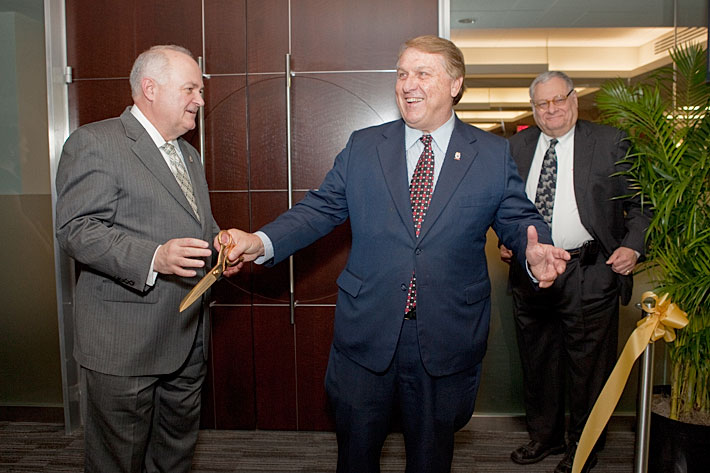Library’s research center is the nation’s first major labor resource to open in 30 years.
By Danny Freedman
University and labor officials snipped the ribbon Wednesday night on the Estelle and Melvin Gelman Library’s newly built labor history research center, opening a rich archive of materials from the International Brotherhood of Teamsters housed there that will help illuminate the story of the union and its past century of work.
“When you’re a new president you walk into a number of conversations, and I don’t think there was a more promising or interesting conversation that I walked into” than that between the IBT and the university, said GW President Steven Knapp, speaking at an evening reception on Kogan Plaza after the opening.
The endeavor offered a chance “to establish an unparalleled center for labor history right here in the heart of the nation’s capital,” one that could become “a magnet for scholars [and] for students interested in labor history,” as well as for members of the Teamsters and other unions, he said.
The IBT Labor History Research Center is the first major labor resource built in the country in more than three decades, according to the library. The Teamsters archive is the cornerstone of the center, though the aim is to continue to build a much broader collection on the history of labor in the United States, as well.
“There’s a tremendous treasure trove of information that is here,” said Teamsters General President James P. Hoffa, ranging from the union’s modern-day contracts and negotiations to a 1906 booklet outlining a union horseman’s pay “for shoeing his horse, for mucking his stall, for putting on the bridle,” he said.
“It’s here for the taking,” Mr. Hoffa said.
The project has been three years in the making. In 2007 the Teamsters contributed $2 million for GW to establish an archive of its historical materials, making them publicly available for the first time.
Construction began in December 2009 and—as several speakers noted, to cheers—was completed using 100 percent union labor.
From the collection’s still-growing tide of documents (memos, research and legislative files, union publications), thousands of photos, thousands more films and videos, and several hundred audio recordings—spanning a century’s-worth of tech platforms—Gelman’s new labor archivist, Tom Connors, says he thinks scholars finally will be able to deeply study the evolution of the Teamsters and “just what makes this union tick.”
In curating the inaugural exhibit, “Teamster Pride is Union Pride: Identity, Community and Solidarity,” Mr. Connors drew from what he found to be a unique “sense of community … a sense of belonging” among members of the Teamsters that set it apart from what he’s seen in other groups.
Through photos, documents (like contracts, strike manuals—even the union’s second constitution, drafted in 1904) and all kinds of tchotchkes bearing the Teamsters logo, the current exhibit is an entrée to the union, tracing its origins and its makeup, and life as a union member.
The Teamsters was formed in 1903 to protect the interests of deliverymen—initially, ones who relied on the kind of horse-power actually supplied by horses. (The group’s logo still reflects that: a “team” of two horses over a wheel.)
Now 1.4 million members strong—still comprising delivery workers and haulers but also a broad swath of workers, from airline mechanics to police officers to zoo keepers—the Teamsters was “a key union in the labor movement in this country,” said Mr. Connors.
“The Teamsters were really a group that would go out and organize people that were shunned by some of [the] other unions,” he said. As the group amassed members in an ever-widening roster of trades, it gained a particular strength in “being in a lot of places but also being very cohesive regionally and of course nationally.”
Along the way, the Teamsters and other unions leveraged their heft to create a slate of worker protections that today are regarded as commonplace among union and non-union workers alike—“things like the weekend, having vacations, having pensions” and health benefits, said Mr. Connors.
The Teamsters also have created a bit of controversy over the years, though, including reputed links to organized crime and three Teamsters presidents who were convicted of crimes and sent to prison.
Among them, the late-president James R. Hoffa, father of the group’s current president, who continued at the helm of the Teamsters from prison for several years. Following his release, the elder Mr. Hoffa disappeared on July 30, 1975 and has been presumed dead for nearly three decades.
Without denying the failings of its leaders or criticisms that the union, at times, has been heavy handed in its dealings, the exhibit and Mr. Connors both come back to the idea of the Teamsters as a massive machine driven in large part by hundreds of smaller parts: the local unions.
The work of the locals, an exhibit plaque reads, is the “lifeblood” of the IBT and they are “the crucible of Teamster pride.”
“When I meet people at the local level, I just find very genuine people,” said Mr. Connors. “A lot of people with good hearts, who are out there just fighting their good fight.”


